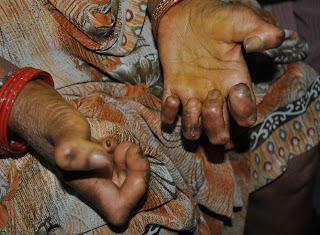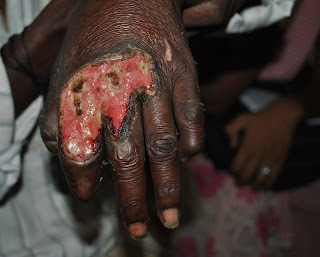Date: 08/07/2011
This is a personal reflection about my work this summer and my last post on this blog. Please excuse the fluctuating volume; this is my first project of this sort. Thanks for following my blog this summer. I'm immensely grateful. Here's a text of the video:
Me and all my friends
We're all misunderstood
They say we stand for nothing and
There's no way we ever could
Nowe we see everything that's going wrong
With the world and those who lead it
We just feel like we don't have the means
To rise above and beat it
So we keep waiting
Waiting for the world to change
We keep on waiting
Waiting on the world to change
--John Mayer
After my experiences this summer, I find that I rather disagree with John Mayer. I just spent six weeks in India studying malnutrition and working with people who were sick because they were poor and poor because they were sick. The one thing that’s clear to me is this: the situation is urgent. Sitting around waiting for it to change will not work.
The bulk of my work this summer involved a case control study that looked at the link between cognition and malnutrition. I was rather surprised at my results and my mentor believes we have prima facie evidence that upholds our hypothesis. I cannot talk more about it here out of privacy, sensitivity, and scientific concerns. Apart from this work, I participated in community health screenings under the supervision of some young doctors from Christian Medical College. The camps were held in villages near Vellore. In three weeks, I met, examined, and spoke to around four hundred individuals. I heard hundreds of complaints about bodyaches and counselled hundreds on their nutritional intake. I also had the privilege of helping out dozens of kids with nutritional issues such as vitamin, calcium, and iron deficiencies by providing them with supplements, deworming tablets, and counseling their parents. There was tremendous satisfaction in the knowledge that such early interventions would have a large ripple effect.
However, my levity and optimism took a titanic blow when I used my newly acquired skill of cardiac auscultation to detect mitral regurgitation in a child and then found that he would probably not be able to afford the necessary treatment. The incident brought me face to face with the limited scope of my interventions. It wasn’t that it was bad. It simply wasn’t enough. We need to go beyond the biomedical level to the socio-economic and political level of medicine.
Of course, any time I mentioned political fixes in India, I was met with a barrage of cynicism and disgruntlement with the political machinery of our country. “There’s no political will”, moans one. “These bloody politicians are all corrupt”, groans another. This isn’t a surprise considering the recent political storm about high level corruption in the Indian government. I like to refute these tigerish outbursts by reminding these indignant folk that we don’t live under the tyrannical rule of a monarch. Votes are the lifeblood of politicians. As public intellectuals, we can agitate and spread awareness so that public health and health inequalities become serious voting issues. This needs to be done not only among the rich and educated but also among the poor and illiterate who are more susceptible to demagogues. Gemlyn George, one of the doctors I worked with this summer opines that Indian politicians don’t find working on public healthcare a lucrative source of votes because the pay-off is slow and is unlikely to benefit them politically in the near future. It’s time to make it worth their while to fix our healthcare nightmare.
One of the issues that is aching for a political remedy is that of the stigma and lack of awareness that plagues Leprosy patients in India. I visited the Schieffelin Leprosy Research & Training Centre near Vellore where I met many patients of Leprosy who quietly endured the deformities and disfigurements that their circumstances had brought onto them. I plan to write a lot about Leprosy and the specific ways in which it can be attacked politically and socio-economically, but I want to dwell here on the moment I shook the clawed hand of a Leprosy patient. It was a feeling of incredibly inadequacy. He had lost his position in society and the use of his hands. What had I lost in my life? The hair on my head? Romantic relationships? This man’s suffering was on a scale beyond my comprehension. I felt petty.
 |
| Dr. Rama, my absolutely amazing mentor. |
My Indian mentor Dr. Ramakrishna pointed out to me that I was witness to the fortitude of the human spirit even in the face of the adversities of poverty and disease. Despite their bereavements, and suffering, the people around me, including some Leprosy patients, smiled. The children frolicked and goaded me brattishly to take their pictures with my camera. I saw a rickety old grandmother dance with a little too much gusto in a shockingly orange sari in her grandchildren’s wedding. Our car got rather delayed one day due to the festive Aadi celebration in which seemingly the entire population of Vellore took to the roads. Life goes on, believe it or not, and not always in a dismal way. I will probably never understand the source of this resilience, but I shall always bow my head in reverence.
We are sitting on a dynamo of human capital that is slowly going to waste to due to stupid reasons. I particularly like analogizing our healthcare situation to a leaking tap. Like the drops of water lost, the loss of human capital does not seem huge at first. However, the drops and lives add up over time. Fixing these small leaks of human capital all over the world would be transformational. The world would change. As educated and relatively prosperous people of the world, we have the tools to do this! We have done so in the past, don’t be cynical about trying again. Most importantly, please don’t sit around waiting with your friends for the world to change. It won’t until you change it.





















